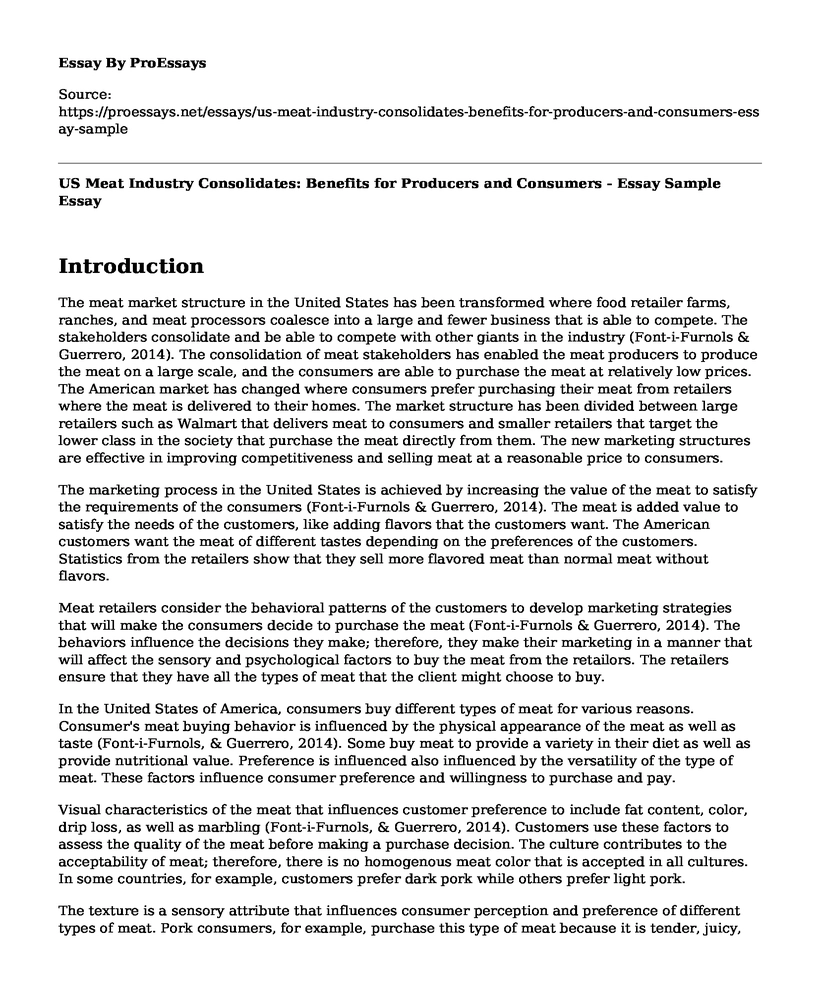Introduction
The meat market structure in the United States has been transformed where food retailer farms, ranches, and meat processors coalesce into a large and fewer business that is able to compete. The stakeholders consolidate and be able to compete with other giants in the industry (Font-i-Furnols & Guerrero, 2014). The consolidation of meat stakeholders has enabled the meat producers to produce the meat on a large scale, and the consumers are able to purchase the meat at relatively low prices. The American market has changed where consumers prefer purchasing their meat from retailers where the meat is delivered to their homes. The market structure has been divided between large retailers such as Walmart that delivers meat to consumers and smaller retailers that target the lower class in the society that purchase the meat directly from them. The new marketing structures are effective in improving competitiveness and selling meat at a reasonable price to consumers.
The marketing process in the United States is achieved by increasing the value of the meat to satisfy the requirements of the consumers (Font-i-Furnols & Guerrero, 2014). The meat is added value to satisfy the needs of the customers, like adding flavors that the customers want. The American customers want the meat of different tastes depending on the preferences of the customers. Statistics from the retailers show that they sell more flavored meat than normal meat without flavors.
Meat retailers consider the behavioral patterns of the customers to develop marketing strategies that will make the consumers decide to purchase the meat (Font-i-Furnols & Guerrero, 2014). The behaviors influence the decisions they make; therefore, they make their marketing in a manner that will affect the sensory and psychological factors to buy the meat from the retailors. The retailers ensure that they have all the types of meat that the client might choose to buy.
In the United States of America, consumers buy different types of meat for various reasons. Consumer's meat buying behavior is influenced by the physical appearance of the meat as well as taste (Font-i-Furnols, & Guerrero, 2014). Some buy meat to provide a variety in their diet as well as provide nutritional value. Preference is influenced also influenced by the versatility of the type of meat. These factors influence consumer preference and willingness to purchase and pay.
Visual characteristics of the meat that influences customer preference to include fat content, color, drip loss, as well as marbling (Font-i-Furnols, & Guerrero, 2014). Customers use these factors to assess the quality of the meat before making a purchase decision. The culture contributes to the acceptability of meat; therefore, there is no homogenous meat color that is accepted in all cultures. In some countries, for example, customers prefer dark pork while others prefer light pork.
The texture is a sensory attribute that influences consumer perception and preference of different types of meat. Pork consumers, for example, purchase this type of meat because it is tender, juicy, and tasty (Font-i-Furnols, & Guerrero, 2014). Preferences of different types of meat vary across customers hence the need to conduct market research to determine the preferences of consumers in a particular location. Market research facilitates an effective marketing process.
Meat supply chain involves four stages, namely inputs, production, processing, and distribution, as well as marketing. In the input stage, farmers need veterinary services, feeds, and breeds to produce quality meat (Boyabatli, Kleindorfer, & Koontz, 2011). In beef cattle farming, for example, the cattle are slaughtered, and the meat is packaged or processed. It is then sold to wholesalers who then sell to restaurants, supermarkets, and other foodservice outlets. The effective operations in these stages allow quick delivery of quality meat to consumers
References
Boyabatli, O., Kleindorfer, P. R., & Koontz, S. R. (2011). Integrating long-term and short-term contracting in beef supply chains. Management Science, 57(10), 1771-1787.
Font-i-Furnols, M., & Guerrero, L. (2014). Consumer preference, behavior, and perception about meat and meat products: An overview. Meat Science, 98(3), 361-371.
Cite this page
US Meat Industry Consolidates: Benefits for Producers and Consumers - Essay Sample. (2023, Jun 20). Retrieved from https://proessays.net/essays/us-meat-industry-consolidates-benefits-for-producers-and-consumers-essay-sample
If you are the original author of this essay and no longer wish to have it published on the ProEssays website, please click below to request its removal:
- Public Relation Strategy and How It Builds Reputation? - Paper Example
- Advice to Ads Rating for May and June Campaign Letter Paper Example
- Digital Marketing vs Traditional Marketing Research Paper Example
- Ethical Challenges of a Global Supply Chain, Analysis and Recommendations Paper Example
- Sabre's E-D.W.: Exec. Dashboards for Performance Metrics & Org. Relevance - Essay Sample
- Product Delivery Questions and Answers Paper Example
- Essay Sample on Internal Conflict Style: Positive & Negative Impacts on Org. Conflict







